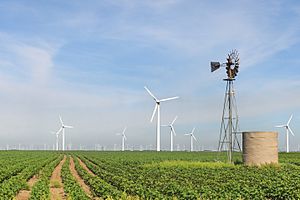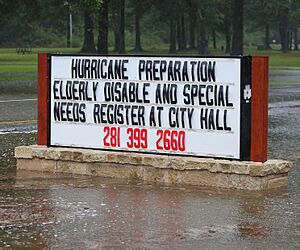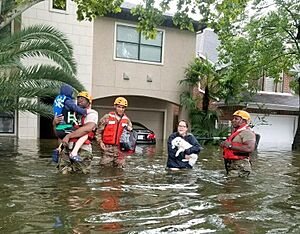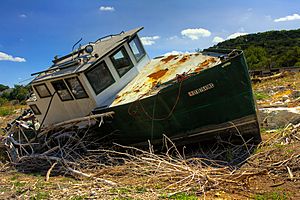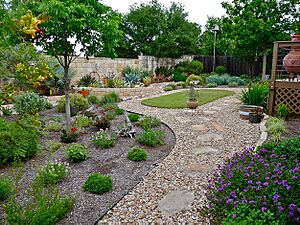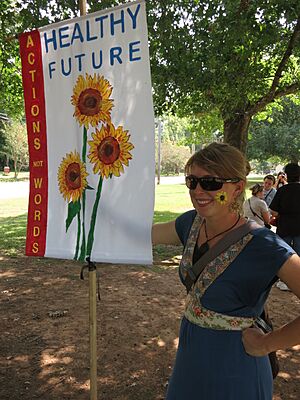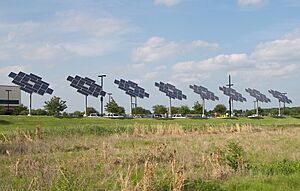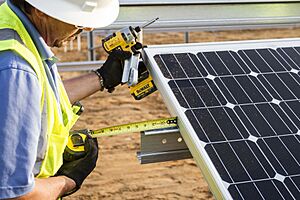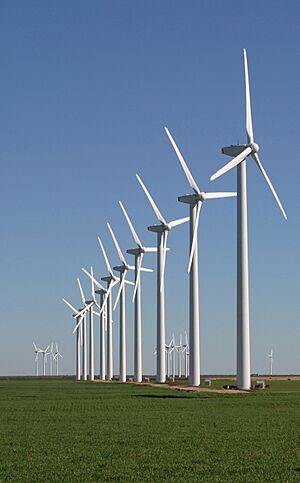Climate change in Texas facts for kids
The climate in Texas is changing. This is partly because of global warming and more greenhouse gases being released. By 2016, most of Texas had already gotten about 1.5 degrees Fahrenheit warmer. This warming is due to greenhouse gases from the United States and other countries.
Texas is expected to face many environmental changes from climate change in the United States. These include rising sea levels, more frequent extreme weather events, and less water resources.
Texas had a fast-growing economy in 2020. A lot of this growth came from making traditional energy sources like oil and natural gas.
Even though Texas has a long history of producing oil and natural gas, renewable energy is growing fast. More jobs in solar energy have appeared. Also, wind farms have been built in West Texas. Texas has a lot of sunshine, flat land, and a good business environment. This means it has great potential to develop more renewable energy in the future.
Many cities in Texas are also taking action. For example, Austin, Houston, Dallas, and San Antonio have started Climate Action Plans. Government groups also have programs like the Texas Emissions Reduction Plan. They also have the Innovative Energy Demonstration Program. These programs help promote renewable energy and climate education in Texas.
Contents
Texas's Energy and Emissions
In 2017, Texas produced the most carbon dioxide emissions in the U.S. In 2018, it was also first in total energy production. By early 2020, Texas's energy came from several sources. These included natural gas, coal, nuclear power, and renewables.
About half of the energy used in Texas came from oil refineries and chemical plants. Texas produced 41% of the country's crude oil. It also produced 25% of its natural gas. And it had 31% of the refining capacity. Texas also has a lot of potential for sustainable energy. It produced 28% of the wind power for the United States.
How Climate Change Impacts Texas
Climate change is expected to have big effects on Texas. Very hot days will likely happen more often. This is because the average temperature is rising. With higher temperatures, the air might become drier. This could lead to more droughts that are longer and more severe.
There will be less water resources available due to climate change. Water scarcity could get worse. This is also because Texas's population is growing fast, increasing water demand.
Also, sea level rise along the Texas coast is expected to be higher than the global average. This means coastal areas will be more at risk from storm surges. Extreme weather events like hurricanes might become stronger. This could cause much more damage and threaten people living there.
Heavy rainfall is also expected to become more frequent and intense. Lighter or normal rains might happen less often. This could lead to drier soil in Texas.
Extreme Weather Events
Overall, the amount of rain or snow on very wet days might decrease in winter. But it could increase in summer. Storms with heavy rain are expected to become more extreme, causing flooding. The number of extremely hot days in summer is also expected to increase. This is due to the general warming trend. Many dry areas in Texas might become like deserts. Or they could lose their ability to support activities like livestock farming.
In 2020, high temperatures and little rain caused a severe drought in Texas. This drought affected many Western and Central states. It lasted from June to December. It caused 45 deaths and an estimated cost of 4.5 billion dollars.
In February 2021, Texas had severe snowstorms. There were also unexpected power outages across the state. Some research suggests these events might have been caused by climate change.
The Fifth National Climate Assessment in 2023 reported that coastal states like Texas are seeing "more significant storms and extreme swings in precipitation."
Hurricane Harvey's Impact
In August 2017, Hurricane Harvey caused huge damage in Greater Houston. It was the second most destructive storm in U.S. history after Hurricane Katrina. Scientists have studied how climate change played a role in Hurricane Harvey. They found that about one-fifth of the total rainfall during Harvey was due to human-caused climate change. This also greatly increased the chances of such heavy rain in Houston.
Studies showed that about one-fifth of the extreme rain in southeast Texas during Harvey was due to warming since 1980. Also, the effects of urbanization and climate change on flooding in Houston were studied. Models showed that climate change could increase peak streamflow by one-fifth. The impact of climate change on flooding can be much worse due to the fast-growing urban areas around Houston.
Coastal Changes
The sea level is rising quickly in many parts of the Texas coast. This is because the land is sinking due to groundwater pumping and climate change. More storm surges are expected along the coast. These changes, along with stronger hurricanes, threaten Texas's coastal buildings. This includes public buildings, oil and gas structures, and homes. They also threaten the lives of people living there. The coastal ecosystem is also at risk. This is due to possible changes in saltiness in coastal wetland areas.
Water Resources
Texas has 15 major river basins. If the climate gets warmer without a big increase in rainfall, water resources could become scarcer. In some parts of Texas, more rainfall could help. But it could also lead to local flooding. Also, climate change could cause more frequent and intense rainfall. This could result in flash flooding.
Surface Water
In a warmer and drier climate, open water will evaporate more. This can cause lakes, rivers, and streams to shrink. It can also lead to less water stored in reservoirs. Meanwhile, more extreme weather and Texas's varied weather make it harder for water managers to handle available surface water.
Groundwater
Overall, Texas's groundwater storage is expected to decrease. This is because less water will recharge the groundwater under climate change. A warmer and drier climate means more evaporation. This leaves less water to refill groundwater aquifers. This is especially true in West Texas, where aquifers are already under stress.
Also, in a warmer climate, drier soil means farming irrigation might need more water. This could increase groundwater pumping for farms. To feed Texas's fast-growing population, the stress on groundwater could negatively affect aquifer water and surface water. So, dryness and water scarcity are very likely to get worse across Texas in the future.
By the end of this century, the Edwards Aquifer is expected to see a big decrease (around 20% - 30%) in recharge. At the same time, water demand will rise a lot in this area due to fast population growth. This could lead to much less water flowing from local springs.
Wildfires
Higher temperatures and drought are likely to make wildfires worse. They could become more severe, frequent, and spread over larger areas. According to Wes Moorehead, fire chief at the Texas A&M Forest Service, "Wildfire in Texas does seem to be a growing problem. We see more and more wildfires, it seems like, every year." As of 2022, Texas has the second highest wildfire risk in the United States. Research from Texas A&M University shows that climate and weather trends in Texas are increasing the wildfire risk.
Actions to Address Climate Change
City Actions
Texas has several groups working on clean energy:
- Alamo Area Clean Cities
- Loan Star Clean Fuels Alliance (Central Texas)
- Dallas–Fort Worth Clean Cities
- Greater Houston Clean Cities
Georgetown, Texas is a city that gets 100% of its power from renewable energy.
Climate Action Plans
Austin's Plan
Austin created the Austin Community Climate Plan in 2015. Its goal is to become carbon neutral by 2050. The plan lists many actions for electricity, natural gas, transportation, land use, and waste management. These actions aim to reduce greenhouse gases. The plan also shows how different community members can help. It explains benefits like lower energy costs and better public transportation.
Houston's Plan
Houston started the Houston Climate Action Plan on April 22, 2020. Its goal is to become carbon neutral by 2050, following the Paris Climate Agreement. The plan focuses on four areas: transportation, energy transition, building improvements, and waste management. They hope the plan will also bring other benefits. These include savings from energy efficiency and less traffic congestion.
Dallas's Plan
Dallas launched the Dallas Comprehensive Environmental and Climate Action Plan on May 27, 2020. Its goal is to cut greenhouse gas emissions by 43% by 2030 and be carbon neutral by 2050. The plan has eight focus areas to reach its goals. These include renewable energy, energy-efficient buildings, sustainable transportation, zero waste, water protection, green spaces, healthy food, and clean air. Dallas plans to use partnerships, grants, loans, and other ways to put its actions into practice. However, there is still a need for more climate education in the Dallas–Fort Worth metroplex. More ways to teach about climate change, like teacher training and museum exhibits, are encouraged.
San Antonio's Plan
San Antonio adopted its first Climate Action and Adaption Plan (CAAP) on October 17, 2019. San Antonio is one of the fastest-growing cities in the U.S. It has been working to reduce greenhouse gases and prepare for climate change. To reach its goals for climate change mitigation and climate change adaptation, a report about CAAP was created. This report helps promote sustainable development.
Renewable Energy Growth
Texas has a long history of producing traditional energy like oil and natural gas. The state legislature is mostly controlled by the Republican Party. Unlike California, most Texas lawmakers are against actions to address climate change. For example, a bill to create a climate adaptation plan for Texas was not passed.
However, the renewable energy industry is growing quickly in Texas. In 2016, there were about 7,000 solar industry jobs in Texas. This number grew to almost 10,000 in 2018. The number of solar jobs in Texas in 2018 was about twice as many as in Illinois. But it was still far behind California. This shows that Texas has great potential to develop more renewable energy. It has advantages like sunny weather, flat land, and a good business environment.
Texas can reduce greenhouse gases by producing more renewable energy. But it also faces challenges. Wind and solar energy depend a lot on the weather. Their production is not continuous. One challenge is balancing electricity supply and demand. Solar energy is only available during the day. Both solar and wind energy change daily and seasonally. Another challenge is the differences across Texas. Things like land shape, land use, and local decisions can affect renewable power.
The total production of wind and solar energy in Texas is expected to grow by 2040-2050. However, studies show there are clear differences in how renewable energy is spread across Texas. So, it's important to study this with more detailed data. This will help understand how climate change affects renewable power in Texas.
Wind Power
Texas has been a top state for wind energy production in the U.S. since 2000. In 2017, wind power made up at least 15.7% of the electricity generated in Texas. Some wind farms have been built in West Texas in recent decades. These wind farms have reduced air pollution. They have also helped local landowners who leased their land for wind power. These landowners had higher incomes. Also, the quality of local public schools has improved. This is because more educated people have moved to the area.
One of the biggest challenges is sending wind power to where it's needed. The best wind source is in the Texas Panhandle in northern Texas. But most people who use electricity live in eastern Texas. There are different ideas about how to solve this. Some people think more power lines are needed. But some environmentalists disagree. There are also concerns about how new power lines might make the renewable energy market in Texas more complex. Overall, Texas has strong natural wind energy resources. And there is growing local support for wind power development.
Grants and Programs
The Texas Emissions Reduction Plan (TERP) offers grants. These grants support projects for cleaner fuels and advanced technology. They also help build the necessary infrastructure. Under TERP, the New Technology Research and Development (NTRD) Program gives money to encourage research and development of pollution-reducing technologies in Texas. This program is managed by the Texas Environmental Research Consortium. It also gets support from the Houston Advanced Research Center. This center focuses on research about sustainable development.
The Texas State Energy Conservation Office (SECO) helps public and private groups get grants. These grants encourage the use of cleaner fuels. This includes using hybrid electric vehicles. It also includes changing government vehicles to run on natural gas, liquefied petroleum gas, hydrogen, biodiesel, and bioethanol. SECO has programs like Clean Energy Incubators and the Alternative Fuel Program. It also has the Innovative Energy Demonstration Program. These programs help Texas deal with the possible effects of climate change.



